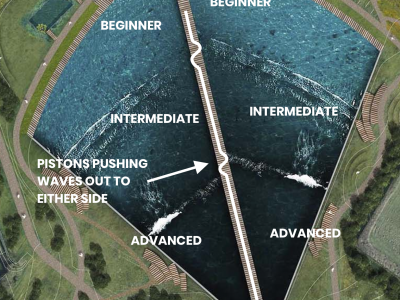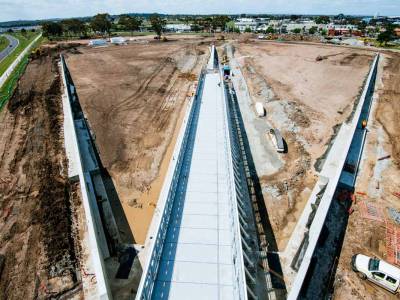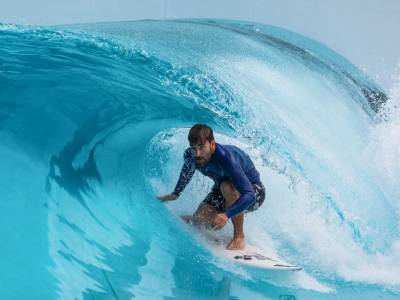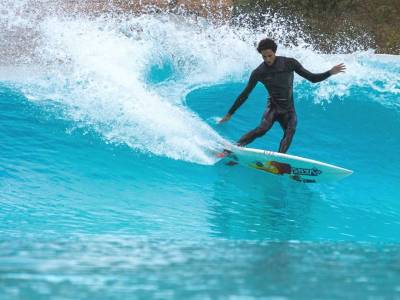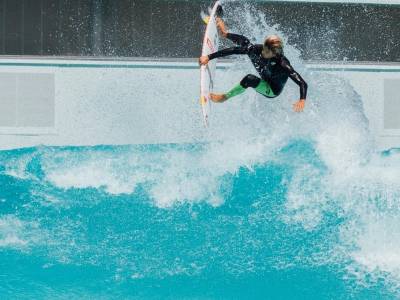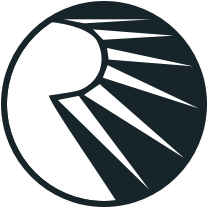Wavegarden Cove
Wavegarden Cove Technology
Wavegarden Cove wave pool technology uses a series of piston-powered-paddles to push waves out to either side of a pier that runs through the center of pool. The pistons fire sequentially, from the back of the pool toward the front, to continually add energy into the wave so that it maintains it size and power for the length of the break. Andrew Ross, founder of URBNSURF, says the sequential timing and motion of the pistons is snake-like, and it results in the wave on one side of the pier being slightly behind the wave on the other side of the pier.
The Wavegarden Cove technology is modular, meaning that the line of wave generation machinery running down the central pier is made up of identical modules. The Wave in Bristol installed 40 modules into 80 meters of their central pier. Each module contains the pistons that push the paddles to generate the wave. The paddles are about spaced out to add energy to the wave every ~1 meter. The modules can be linked up, as long as necessary, to accomodate larger pools and longer rides. Additionally, according to Wavegarden, if one of the modules breaks down it can be replaced or repaired without interfering with wave creation. Nick Hounsfield, founder of The Wave company, told Magic Seaweed that “We can actually lose up to 30 per cent of those modules and there will still be a wave good enough to surf."
Wave Size and Shape
As the wave propagates away from the pier on either side, it moves from deeper to shallower water which causes the wave to stand up, crest and break. The first break the wave encounters, called “The Reef" is intended for advanced and intermediate surfers. According to Wavegarden, waves on The Reef can reach 2.4m (8 feet) high on the face of the wave. On one side of the pier, the Reef breaks left and on the other side it breaks right. The shape and size of the waves at the Reef depend on the settings controlled by the operator, but the advanced wave can offer barrel, air, and high-performance turning sections.
Read More
After the wave energy passes through the advanced section, it reforms into “The Peak" that’s intended for intermediate surfers.
The Peak will offer waves roughly half the size of the waves on the Reef. In standard installations the shape will resemble something more like Malibu, CA. Surfers on either side of the reef will be able to choose between left and right-hand waves. The shape and size will depend on the settings controlled by the operator, but the Peak will generally offer mellow waves with an open face for practicing turns or riding high-volume craft.
In the shallowest part on either side of the pool, on either side of the pier, The Bay will offer beginner waves. These knee-high whitewater rollers are perfect for beginners surfing for the first time.
The length of ride in all areas of the pool depend on the size of the pool and the details of the bottom configuration, which may vary from one installation to the next. However, based on the what we’ve seen from the Wavegarden R&D center and what we’ve heard from Cove customers, smaller Cove installations will provide rides around 10 seconds in the Reef area while larger installations will run around 15 seconds. The length of rides at the Peak and the Bay will run 7-10 seconds.
Surfers have repeatedly said that the waves in Cove facilities feel like ocean waves. Wavegarden claims this is based on their groundbreaking technology that replicates the exact water particle movement of ocean ground swells.
Capacity and Productivity
Wavegarden loves to claim “1000 Waves per Hour", but let’s break that down and clarify it.
Wavegarden says they will create a wave (on both sides of the pool) every 8 seconds, and they have video of the Cove model at the Wavegarden R&D center doing just that. That’s 450 waves generated each side per hour. On each side, that wave hits the Reef first which produces a ride for one person. With two sides to each Cove pool, that means that a Cove can produce a total of 900 advanced rides on the Reef areas per hour.
Remember, after breaking on the Reef areas, the waves reform to break again providing more rides for intermediate and beginner surfers. The number of surfers in the beginner and intermediate areas, as well as the wave catching frequency will depend on the operators and customer froth levels. But, assuming at least one intermediate and one beginner ride the reformed wave on each side of the pier, then a standard Wavegarden Cove would produce 2700 rides per hour.
What really matters to customers is the number of waves they get to surf in a one-hour session. This is obviously subject to how the wave pool owners decide to run their business, but Wavegarden says a mid size cove will accomodate 100 surfers per hour (50 experienced and 50 beginners). By splitting the 50 experienced surfers between the two sides of the pool, you get 25 in each Reef area. Each Reef area gets 450 waves per hour, so each surfer could get up to 18 waves per one-hour session.
Based on what we’ve seen at URBNSURF Melbourne and The Wave in Bristol, the number of waves produced per hour in a commercial Wavegarden Cove is notably lower due to settling time and other operational considerations. Most Wavegarden Cove installations are promising around 12 waves per surfer per hour in their advanced and intermediate sessions.
Settling time is a major component of the productivity equation, so companies like Wavegarden put millions of dollars into minimizing it. The Cove uses patented bathymetry to move the water around the pool efficiently without impacting waves. The Wavegarden team also patented dissipative shores that help minimize settling time by reducing backwash and currents.
The Wave Pool
Like other wave pool technologies, Wavegarden Cove wave pools come in a variety of shapes and sizes.
The standard diamond shape can be adjusted to match natural features or requirements of the installation site. Those adjustments can also include asymmetrical pools.
The minimum size of a wave pool is approximately 120x120m (394x394ft) which is 1.4 hectare or 3.5 acres. The standard/full size Wavegarden Cove is 150x150m (492x492ft) which is 2.25 hectare or 5.6 acres. As mentioned above, the modular wave generation technology can be added to accomodate larger pools as necessary.
The depth of the pool in the Bay area averages between 0.5-1.2m (1.6-3.9ft). In the Reef areas, the average depth is 1.0-2.5m (3.2-8.2ft).
Wavegarden Cove wave pools can operate with fresh and salt water.
Controlling Wavegarden Cove Pools
Wavegarden Cove facilities are controlled using software that allows the operator to change wave frequency, size and shape with the push of a button. As part of the testing and commissioning process, the Wavegarden team works with the developer to create a customized set of waves that support the business plan. For example, URBNSURF in Melbourne and The Wave in Bristol have different wave “menus" that they pull from for each session. The software lets the operator select individual waves or a “playlist" of waves that match the needs for ongoing surf session.
Energy Consumption
Energy consumption will vary with each wave pool installation and the cost of electricity. Wavegarden claims that a single wave, 1.8-2m (5.9-6.6ft) high on the face of the wave, that can be ridden for 15 s costs 0,10€ ($0.11 USD) to produce.
Wave Pools Powered by Wavegarden Cove Technology
Highlights and Lowlights
| 1000+ rides per hour. | |
| A variety of wave shapes including barrels. | |
| Repair and replace machinery without downtime. | |
| Waves that feel similar to ocean waves. |
| Long backlog of projects. |

